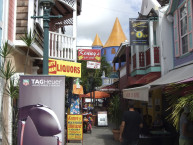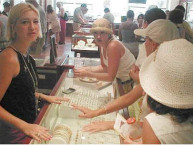Alexandrite
Alexandrite was first discovered in Russia’s Ural Mountains near Ekaterinburg during the reign of Nicholas I. It was named Alexandrite to commemorate the Czar’s oldest son Alexander II coming of age.
Alexandrite is actually a form of Chrysoberyl with a rare presence of chrome traces. A unique characteristic of Alexandrite is that it changes color from soft green or blue in sunlight to deep purple or red in candle or artificial light.
that it changes color from soft green or blue in sunlight to deep purple or red in candle or artificial light.  This change can dramatically be seen by taking the gem and walking about the jewelry store, near the windows and away again. The color change should be rapid. The customer usually returns to the jewelry case smiling and saying “wow!!” The jeweler is nervous. Why??? The rarity of Alexandrites, especially the quality ones found in the Caribbean Jewelry stores, makes them one of the most expensive gems on the planet.
This change can dramatically be seen by taking the gem and walking about the jewelry store, near the windows and away again. The color change should be rapid. The customer usually returns to the jewelry case smiling and saying “wow!!” The jeweler is nervous. Why??? The rarity of Alexandrites, especially the quality ones found in the Caribbean Jewelry stores, makes them one of the most expensive gems on the planet.
If a person wanted to buy a pick-up truck load of fine diamonds, and had the money, he could. If a person wanted to buy a bushel of Alexandrites, no matter what the cost, he couldn’t. There just aren’t that many on this planet.
Alexandrite is also sometimes available as an unset stone but it is extremely rare in fine qualities. The original source in Russia’s Ural Mountains has long since closed after producing for only a few decades and only a few stones can be found on the market today. Material with a certificate of Russian origin is still particularly valued by the trade. Some alexandrite is found in Sri Lanka and Zimbabwe and Brazil but very little shows a dramatic color change. For many years, alexandrite was almost impossible to find because there was so little available.
Then in 1987, a new find of alexandrite was made in Brazil at a locality called Hematita. The Hematita alexandrite shows a striking and attractive color change from raspberry red to bluish green. Although alexandrite remains extremely rare and expensive, the production of a limited amount of new material means a new generation of jewelers and collectors have been exposed to this beautiful gemstone, creating an upsurge in popularity and demand.
When evaluating alexandrite, pay the most attention to the color change: the more dramatic and complete the shift from blue or green to purple, without the bleeding through of brown from one color to the next, the more rare and valuable the stone. The other important value factors are the attractiveness of the two colors – the more intense the better – the clarity, and the cutting quality. Because of the rarity of this gemstone, large sizes command extremely high premiums.
Beware when shopping for Alexandrites that it is a “Natural” alexandrite. Not lab created or a synthetic corundum. There are also doublets with a good color change on the market, red garnet on the top, red glass underneath. The difference between a fine Natural Alexandrite and a lab created or synthetic corundum is like night and day.
With natural Alexandrites becoming more rare and prices increasing people take advantage of those who don’t ask questions. A fine quality natural alexandrite usually will come with a certificate stating exactly what it is. A CGI certificate means the gem has been carefully examined under the microscope by a Gemologist, the color change tested and graded, on the certificate for you to see. Be wary of any jeweler who states you don’t need this.
Cats Eye Alexandrites are a very rare form of Alexandrite. Its appearance is semitransparent to semi translucent, yellow to yellowish green, grayish green, brown to brownish yellow. Chatoyancy may also show a color change, extremely rare cases of 4-ray asterism instead of chatoyancy.
The largest cut Alexandrite in existence weighs 66 carats and is kept at the Smithsonian Institute in Washington DC The largest uncut Alexandrite in existence, The Sauer Alexandrite, weighs 122,400 carats (55 lbs.) and is currently on display at Amsterdam Sauer in St. Thomas USVI.
The Sauer Alexandrite was discovered in August, 1967 by Roger Sauer, founder and chairman of Amsterdam Jewelers, in the Jaqueto district in the state of Bahia, Brazil.
Recognizing the significance of his discovery, Mr.Sauer decided to keep this unique gemstone as an addition to his own private collection. This private collection, which began in 1940, includes many rare and valuable gemstones, but none that would prove to be as rare or valuable as the Sauer Alexandrite .
Care of your Alexandrite: This gem is sensitive to knocks, it is not resistant to Alkalis. Cleaning methods which are safe are ultrasonic, steamer or warm soapy water. When you are not wearing your alexandrite place it in a clean cloth pouch in a separate compartment from other gems to avoid scratching.
Alexandrite is the birthstone for June and is the anniversary gemstone for the 45th and 55th year of marriage.



